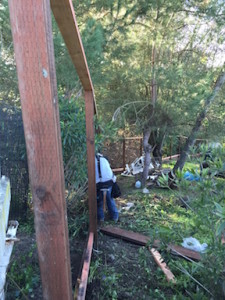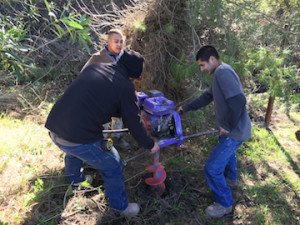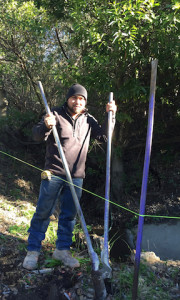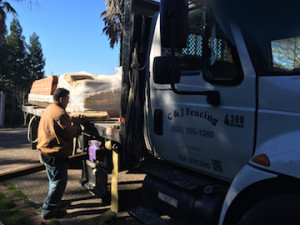
By Cynthia Brian
âGood fences make good neighbors.â Robert Frost
Growing up on a ranch we had all kinds of enclosures. Fences to keep the cattle in, fences to keep the deer out, coops for the chickens, hutches for the rabbits, paddocks for the horses, pens for the sheep, and extra corrals for the injured animals weâd rehabilitate before release. What we didnât have were human fences.

While traveling to the East Coast and the Southern states, I noticed a lack of fences between homes. Lawns rolled into one another, gardens meandered, play structures appeared to belong to no one or everyone. In the California sierras, the same mentality holds true for many homeowners. But in the cities and suburbs of California, strong fences create good neighbors, especially if you live near a house that reminds you of Miss Havishamâs ruined mansion in Charles Dickens, Great Expectations, albeit with abandoned cars on blocks, rusting washing machines, and a backyard piled high with trash. The sturdy redwood fence dividing your properties could be your sanity savior.
Here in our neck of the woods we experience a different kind of problem. Deer! With few predators and plenty of open space deer have been multiplying exponentially. This is not good news for gardeners. Of all the correspondence I receive from readers, the majority of the questions concern these trespassing foragers.
âWhat can I plant that deer wonât eat?â
âHow can I keep the deer from breaking my sprinkler systems?â
âWhat can I do to keep the deer out of my garden?â
Over the years Iâve written articles about our dear deer and after three decades of trying literally every trick suggested, I am convinced that there is only one answer.

Build a fence!
I decided to call several fencing companies to find out if they have experienced a rise in requests for deer fencing. The answer was a resolute âYES!â Â Ryan Collins, the estimator for C & J Fencing, informed me that 95% of the calls he had been on in the last month were all related to building deer fencing. Despite the fact that C & J builds custom decks, arbors, handrails and benches as well as offering ornamental iron and chain link, putting in redwood and galvanized wire deer barriers has become an important part of protecting landscapes.

If you are considering installing a fence, repairing, upgrading, or replacing an old one, as a homeowner, what do you really need to know? I interviewed Ryan more in depth and also tagged along on an installation. Here are some tips that I gratefully learned through the generosity of C & J as well as my own observations.
1. Get recommendations from friends, family, or neighbors you trust.
2. Invite two or three legitimate companies to look at your location and bid your job. Ask how long each has been in business. Make sure all are licensed, carry Workmanâs Comp Insurance, General Liability Insurance, and Auto Insurance.
3. To be fair to all, make sure each estimator is bidding apples for apples. Show each of the contractors exactly where you want the installation, share your expectations, and your fears, if any. Be clear on how high you want your fence. To keep the deer and coyotes out of your garden, seven feet is the recommendation.
4. Ask and get in writing the materials that will be used. Will the fence be redwood, Douglas fir, pressure treated, metal, chain link, or something else? How deep will the posts be set? (Two feet or more is best) How much concrete will be used? If using wood, are the posts to be set eight feet on center with sixteen-foot top rails? Where will gates be placed? Is the wire galvanized welded? Is there an up charge for the longer lasting black or green vinyl coated wire?
5. What is the experience and expertise of the crew who will handle the job?
6. How soon can the fence be started and completed?
7. Does the company contact the utility companies or is it the obligation of the homeowner to know where pipes, cable, electrical, and gas lines reside? If it is the homeownerâs responsibility, call 811 to schedule a free inspection.
8. Is the leftover debris recycled? What happens to it?
9. Is there a warranty and if so, how long?
10. When is payment due?

Costs vary widely between companies. Most fencing companies quoted an additional $2.00 a linear foot for the upgrade to the green or black vinyl coated wire while another company quoted $5.00 a linear foot. Some companies offered discount coupons, others were willing to negotiate within reason based on client needs. They key is to know exactly what you want and ask for it. Although a wood and wire fence could last twenty-five years or longer, warranties for the pressure treated posts and kickboards tended to be fifteen years and gates one year. Other than special order items which required a deposit, payment for the structure is due upon completion according to the companies I interviewed.
Once you have installed a redwood fence, should it be left natural, stained, or painted? Mr. Collins indicated that this is a personal choice, however, staining or painting will extend the life of the wood because it will be better protected from the elements, especially moisture.

I watched C & Jâs crew chief, Lopez, with his six man crew as they were unloading trucks, digging postholes, hauling bags of concrete, cutting wood, and erecting the fence. Every person was on his game, non-stop working until the job was finished and the area cleaned and cleared. Depending on the size of the job, a crew consists of two to four men, with a few more usually arriving the first day to unload. Lopezâs crew were so impressive that I asked Ryan if all of the twelve crews run by C & J were equally as hard working and diligent? He responded that because C & J is a family-run business, each crewmember is hand picked resulting in a pride of ownership mentality. Many times they hire siblings of a dedicated worker. Lopez, an eight-year veteran of C & J, brought his two brothers on board.
This information made me realize that asking about the expertise and work ethics of the specific crew assigned to a project is a very critical part of hiring the right company for the job. Â I wondered if some companies were charging higher fees because of El Nino. (I had heard that roofing companies were known for that practice.) Â Ryan responded that a company with integrity quotes the same fees year round. Many people believe the misconception that winter is a time when fencing contractors scramble for work, but that is not the case. If you need a fence, do it when you want it. Donât wait.

To help you explore your options, here are four local companies to consider:
C & J Fencing
925-355-1380
www.CandJfencing.com
A & J Fencing
925-939-2105
www.AandJfencing.com
Borg Fence
925-290.8818
www.BorgFence.com
Burton Fencing
925-290-7840
www.BurtonFencing.com
Strong fences are an excellent investment. Fences offer privacy, safety, curb appeal, and critter deterrence. If you love your garden and itâs being eaten by our abundant wildlife or invaded by unwanted creatures, the final solution is to fence yourself in. Good fences make good neighbors and they keep the coyotes and our dear deer out!

Spring is around the corner and our trees are full of buds and blossoms. Enjoy the beauty and the fragrance.
Happy Gardening! Happy Growing!
Read more
©2016
Cynthia Brian
The Goddess Gardener
Starstyle® Productions, llc
Cynthia@GoddessGardener.com
www.GoddessGardener.com
925-377-STAR
Tune into Cynthiaâs Radio show at www.StarStyleRadio.comÂ
Garden and plant consultations by appointment; hourly rates apply.





